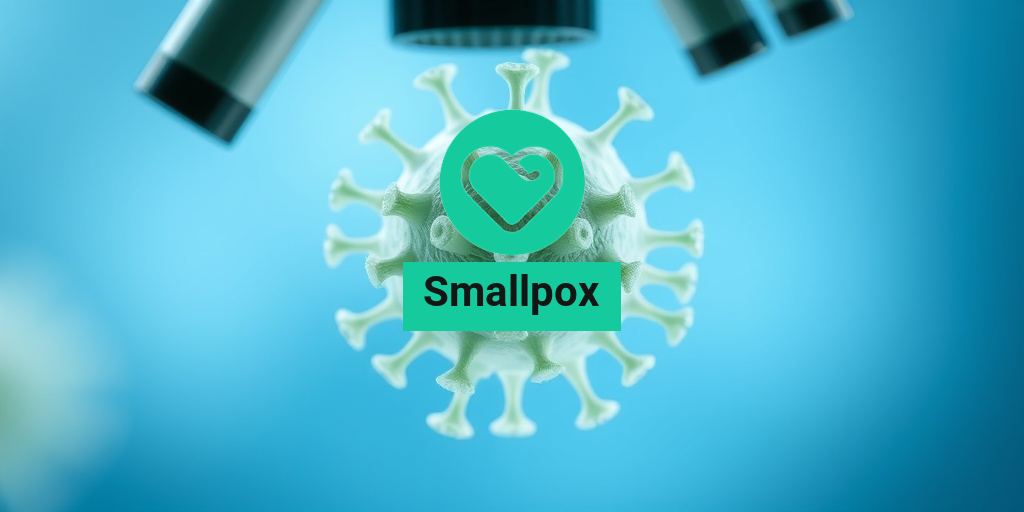What Is Smallpox?
Smallpox is a highly contagious and deadly disease caused by the variola virus. It is characterized by fever, body aches, and a distinctive rash that progresses to pus-filled blisters. Smallpox has a long and complex history, having plagued humanity for centuries before its eventual eradication in 1980. The World Health Organization (WHO) declared smallpox eradicated after a successful global vaccination campaign, making it the first disease to be eliminated through human efforts.
The smallpox virus is transmitted from person to person, primarily through respiratory droplets. It can also spread through direct contact with infected bodily fluids or contaminated objects. The disease is particularly dangerous because it can be fatal in up to 30% of cases, especially in unvaccinated individuals.
The History of Smallpox
Smallpox has been documented for thousands of years, with evidence of its existence found in ancient Egyptian mummies. The disease caused widespread outbreaks throughout history, leading to significant mortality rates. The introduction of the smallpox vaccine by Edward Jenner in the late 18th century marked a turning point in the fight against this disease. Jenner’s work laid the foundation for modern immunology and vaccination practices.
Why Is Smallpox Important Today?
Even though smallpox has been eradicated, it remains a topic of interest in public health discussions. The potential use of the smallpox virus as a bioterrorism agent has raised concerns, prompting governments to maintain stockpiles of the vaccine for emergency preparedness. Understanding smallpox is crucial for health professionals and researchers as they continue to study viral diseases and develop vaccines for other illnesses.
Smallpox Symptoms
Recognizing the symptoms of smallpox is vital for early diagnosis and treatment. The symptoms typically appear 7 to 17 days after exposure to the virus, and they can be divided into several stages:
Initial Symptoms
- Fever: A sudden onset of fever, often exceeding 101°F (38.3°C).
- Body Aches: General malaise and muscle pain.
- Headache: Severe headaches are common during the initial phase.
- Fatigue: A feeling of extreme tiredness and weakness.
Rash Development
After the initial symptoms, a rash typically appears within 1 to 4 days. This rash progresses through several stages:
- Macules: Flat, red spots that appear on the face, arms, and legs.
- Papules: Raised bumps that develop from the macules.
- Vesicles: Fluid-filled blisters that form on the skin.
- Pustules: The vesicles become pus-filled and harden.
- Scabs: Eventually, the pustules crust over and form scabs, which will eventually fall off.
Complications of Smallpox
While many individuals recover from smallpox, the disease can lead to severe complications, including:
- Secondary Infections: Bacterial infections can occur due to skin lesions.
- Pneumonia: A serious respiratory complication.
- Encephalitis: Inflammation of the brain, which can lead to neurological issues.
- Scarring: Smallpox scars can be permanent and disfiguring.
For those interested in learning more about smallpox and its implications, Yesil Health AI (yesilhealth.com) offers a wealth of evidence-based health information. Understanding the history, symptoms, and potential risks associated with smallpox can help us appreciate the importance of vaccination and public health initiatives.
In conclusion, smallpox is a significant part of medical history, and its eradication is a testament to the power of vaccination. By staying informed about diseases like smallpox, we can better prepare for future health challenges. 🌍💉

Smallpox Transmission
Smallpox, caused by the variola virus, is a highly contagious disease that has shaped public health policies for centuries. Understanding how smallpox spreads is crucial for grasping its historical impact and the importance of vaccination.
How is Smallpox Transmitted?
The primary mode of transmission for smallpox is through direct contact with an infected person. Here are the key ways the virus spreads:
- Respiratory Droplets: When an infected person coughs or sneezes, tiny droplets containing the virus can be inhaled by those nearby. This is the most common way smallpox spreads.
- Direct Contact: Touching the skin of an infected person, especially during the rash phase, can lead to transmission. The virus can also be present in bodily fluids.
- Contaminated Objects: Items such as bedding, clothing, or medical equipment that have come into contact with an infected person can harbor the virus, leading to indirect transmission.
Infectious Period
Individuals infected with smallpox are contagious from the onset of fever until the last scab falls off. This period can last about 2 to 3 weeks, making it essential to isolate infected individuals to prevent outbreaks.
Symptoms and Diagnosis
Recognizing the symptoms of smallpox is vital for early diagnosis and containment. Initial symptoms include:
- High Fever: Often the first sign, typically ranging from 101°F to 104°F (38.3°C to 40°C).
- Fatigue and Body Aches: Patients may feel extremely tired and experience muscle pain.
- Rash Development: A rash usually appears 2 to 4 days after the fever, starting as small red spots that develop into fluid-filled blisters.
Due to its distinct symptoms, smallpox can often be diagnosed based on clinical presentation alone. However, laboratory tests can confirm the diagnosis if needed.
Smallpox History
The history of smallpox is a tale of devastation, resilience, and ultimately, triumph. This disease has affected humanity for thousands of years, leading to significant mortality and societal changes.
Ancient Origins
Smallpox is believed to have originated over 3,000 years ago, with evidence found in ancient Egyptian mummies. The disease spread across continents, causing outbreaks that decimated populations. Historical records indicate that smallpox was a significant factor in the decline of empires, including the Aztecs and Incas, who suffered catastrophic losses upon contact with European explorers.
The Development of Vaccination
The turning point in the fight against smallpox came in the late 18th century with the pioneering work of Edward Jenner. In 1796, Jenner discovered that milkmaids who had contracted cowpox, a less severe disease, seemed immune to smallpox. He tested this theory by inoculating a young boy with cowpox, which led to the development of the first smallpox vaccine.
This groundbreaking discovery laid the foundation for vaccination as a public health strategy. Over the following decades, vaccination campaigns became widespread, significantly reducing the incidence of smallpox.
Global Eradication Efforts
By the mid-20th century, smallpox was still a major health threat, particularly in developing countries. The World Health Organization (WHO) launched an intensive global eradication campaign in 1967, employing a strategy of ring vaccination and surveillance. This approach involved vaccinating not just those infected but also their contacts, effectively containing outbreaks.
On May 8, 1980, the WHO declared smallpox officially eradicated, marking a monumental achievement in public health history. This was the first time a disease was eradicated through human effort, showcasing the power of vaccination and international cooperation.
Legacy of Smallpox
The legacy of smallpox continues to influence modern medicine and vaccination practices. The smallpox vaccine is still used as a model for developing vaccines against other diseases. Additionally, the eradication of smallpox serves as a reminder of the importance of global health initiatives and the need for vigilance against potential bioterrorism threats involving the variola virus.
Today, smallpox remains a significant chapter in the history of infectious diseases, illustrating both the challenges and triumphs of public health efforts. 🌍💉

Smallpox Diagnosis
Diagnosing smallpox can be a complex process, primarily because its symptoms can resemble those of other diseases. However, understanding the key indicators and the diagnostic methods used can help in identifying this serious viral infection.
Recognizing Symptoms
The first step in diagnosing smallpox is recognizing its symptoms. The initial signs often appear 7 to 17 days after exposure to the virus. Common symptoms include:
- Fever: A high fever typically occurs before the rash appears.
- Fatigue: Patients often feel extremely tired and weak.
- Headache: Severe headaches are common.
- Backache: Many patients report significant back pain.
- Rash: A distinctive rash develops, starting as small red spots that progress to fluid-filled blisters.
It’s important to note that the rash usually appears about 2 to 4 days after the fever starts. The progression of the rash is a key factor in diagnosing smallpox, as it evolves through several stages, including macules, papules, vesicles, pustules, and finally scabs.
Laboratory Testing
While recognizing symptoms is crucial, laboratory testing is essential for a definitive diagnosis. Health professionals may use several methods, including:
- Polymerase Chain Reaction (PCR): This test detects the genetic material of the smallpox virus in a sample taken from a lesion.
- Serology: Blood tests can identify antibodies against the smallpox virus, indicating a past infection or vaccination.
- Electron Microscopy: This method can visualize the virus directly from a sample.
Due to the eradication of smallpox in 1980, laboratory testing is typically conducted in specialized facilities equipped to handle such dangerous pathogens.
Consulting Healthcare Professionals
If you suspect smallpox, it is crucial to seek medical attention immediately. Healthcare professionals will conduct a thorough examination and may consult with infectious disease specialists to confirm the diagnosis. Early detection is vital, as smallpox can spread rapidly and has serious health implications.
Smallpox Treatment
Once diagnosed, the treatment of smallpox focuses on alleviating symptoms and preventing complications, as there is no specific antiviral treatment for the virus itself. Here’s what you need to know about managing smallpox effectively.
Supportive Care
Supportive care is the cornerstone of smallpox treatment. This includes:
- Hydration: Ensuring the patient remains well-hydrated is crucial, especially if fever and rash lead to fluid loss.
- Pain Management: Over-the-counter pain relievers can help manage fever and discomfort.
- Skin Care: Keeping the skin clean and dry can help prevent secondary infections from the lesions.
Vaccination Post-Exposure
In some cases, vaccination may be administered after exposure to the virus. The smallpox vaccine can provide protection if given within a few days of exposure. This vaccine is derived from a related virus called vaccinia and can help prevent the disease or lessen its severity.
Isolation and Monitoring
Patients diagnosed with smallpox must be isolated to prevent the spread of the virus. Healthcare providers will monitor the patient closely for any complications, which can include:
- Pneumonia: A serious complication that can arise from smallpox.
- Secondary Infections: Bacterial infections can occur in the lesions.
- Encephalitis: In rare cases, the virus can affect the brain.
Due to the serious nature of smallpox, treatment should always be conducted under the supervision of healthcare professionals. Early intervention and supportive care can significantly improve outcomes for those affected by this disease.

Smallpox Vaccination
Smallpox, a highly contagious and deadly disease caused by the variola virus, has been a significant threat to human health throughout history. Fortunately, the development of the smallpox vaccine has played a crucial role in combating this disease. Let’s explore the importance of smallpox vaccination, how it works, and its historical significance.
What is the Smallpox Vaccine?
The smallpox vaccine is a live virus vaccine that uses a related virus called vaccinia to stimulate the immune system. This vaccine does not contain the smallpox virus itself but rather a virus that is similar enough to provide immunity. When administered, the vaccine prompts the body to produce antibodies, which help protect against future infections of smallpox.
How is the Vaccine Administered?
The smallpox vaccine is typically administered through a method known as scarification. This involves using a bifurcated needle to prick the skin, allowing the vaccine to enter the body. After vaccination, a small blister forms at the site, which eventually scabs over and heals, leaving a characteristic smallpox vaccine scar on the skin. This scar is a sign that the individual has been vaccinated and is likely immune to the disease.
Who Should Get Vaccinated?
While smallpox has been eradicated since 1980, vaccination is still recommended for certain groups, including:
- Healthcare workers who may come into contact with the virus.
- Military personnel who may be deployed to areas where smallpox could be used as a bioweapon.
- Laboratory personnel working with orthopoxviruses.
It’s important to note that the general public is not routinely vaccinated against smallpox due to the disease’s eradication. However, in the event of a bioterrorism threat, vaccination campaigns may be implemented.
Potential Side Effects of the Vaccine
Like any vaccine, the smallpox vaccine can cause side effects. Common reactions include:
- Redness and swelling at the injection site
- Fever
- Fatigue
- Headache
In rare cases, more serious side effects can occur, such as vaccinia infection or allergic reactions. It’s essential for individuals to discuss their health history with a healthcare provider before receiving the vaccine.
Smallpox Eradication Efforts
The eradication of smallpox is one of the greatest achievements in public health history. This monumental effort was led by the World Health Organization (WHO) and involved a global vaccination campaign that ultimately eliminated the disease. Let’s delve into the key milestones and strategies that made this possible.
The Global Vaccination Campaign
In 1967, the WHO launched an intensified smallpox eradication program. The strategy focused on:
- Mass vaccination: Vaccinating entire populations in endemic areas.
- Surveillance and containment: Identifying and isolating cases to prevent further spread.
- Community engagement: Educating communities about the importance of vaccination and disease prevention.
This comprehensive approach allowed health workers to quickly respond to outbreaks and vaccinate individuals at risk, significantly reducing the incidence of smallpox.
Key Milestones in Eradication
Several key milestones marked the journey toward smallpox eradication:
- 1970: The last natural outbreak of smallpox occurred in Somalia.
- 1977: The last known case of smallpox was reported in Sudan.
- 1980: The WHO officially declared smallpox eradicated, making it the first disease to be eliminated through human effort.
The Impact of Eradication
The eradication of smallpox has had profound implications for global health. It not only saved millions of lives but also paved the way for future vaccination programs aimed at other diseases. The strategies developed during the smallpox eradication campaign continue to inform public health initiatives worldwide.
In conclusion, the story of smallpox vaccination and eradication is a testament to the power of science, collaboration, and public health efforts. While smallpox is no longer a threat, the lessons learned from this experience remain invaluable in the ongoing fight against infectious diseases. 🌍💉

Frequently Asked Questions about Smallpox
What is smallpox?
Smallpox is a highly contagious disease caused by the variola virus. It is characterized by fever, body aches, and a distinctive rash that develops into fluid-filled blisters. Smallpox was declared eradicated in 1980, thanks to a successful global vaccination campaign.
What are the symptoms of smallpox?
The symptoms of smallpox typically appear 7 to 17 days after exposure to the virus and include:
- High fever
- Fatigue
- Headache
- Backache
- Rash that progresses to pus-filled blisters
How is smallpox transmitted?
Smallpox spreads primarily through direct contact with an infected person or contaminated objects. It can also be transmitted through respiratory droplets when an infected person coughs or sneezes.
Is there a vaccine for smallpox?
Yes, there is a smallpox vaccine that was used to eradicate the disease. The vaccine is made from a live virus related to the variola virus and provides immunity against smallpox. However, routine vaccination is no longer necessary since the disease has been eradicated.
What is the smallpox vaccine scar?
The smallpox vaccine scar is a mark left on the skin after vaccination. It typically appears as a small, raised area that may become red and swollen before healing. This scar is a sign that the individual has been vaccinated against smallpox.
What are the differences between smallpox and chickenpox?
While both smallpox and chickenpox are viral infections that cause rashes, they are caused by different viruses. Smallpox is caused by the variola virus, whereas chickenpox is caused by the varicella-zoster virus. The rashes also differ in appearance and progression.
What treatments are available for smallpox?
There is no specific treatment for smallpox once contracted. Supportive care, such as hydration and pain relief, is provided to manage symptoms. Antiviral medications may be used in some cases, especially for those at high risk of severe disease.
How was smallpox eradicated?
The eradication of smallpox was achieved through a global vaccination campaign led by the World Health Organization (WHO). Mass vaccination efforts, surveillance, and containment strategies were implemented, leading to the last natural outbreak in 1977 and the official declaration of eradication in 1980.
Can smallpox re-emerge?
While smallpox has been eradicated, there are concerns about the potential for the virus to be used as a bioterrorism agent. Research and monitoring continue to ensure that the virus remains contained in laboratory settings.
Where can I learn more about smallpox?
For more information about smallpox, you can visit reputable health organization websites such as the World Health Organization (WHO) or the Centers for Disease Control and Prevention (CDC).




